GBS 495: Unit 9 Entrepreneurship and Small Business Management Report
VerifiedAdded on 2021/08/30
|15
|4133
|28
Report
AI Summary
This report, prepared as a business brochure, explores the landscape of entrepreneurship in Vietnam, focusing on its significance in the global economy and its contribution to socio-economic development. It categorizes and defines various entrepreneurial ventures, including small businesses, global entrepreneurs, high-growth firms, and social enterprises, providing real-world examples like Starbucks and Google. The report analyzes the macro and micro environments affecting these ventures using PESTEL and McKinsey 7S models, respectively. It highlights the similarities and differences between ventures, such as tax implications and the application of the McKinsey 7S model in a Japanese company. Furthermore, it emphasizes the critical impact of micro and small businesses on the Vietnamese economy, including their contribution to GDP, employment, and industrial output, and acknowledges the rise of innovative startups. The report concludes by underscoring the importance of small businesses and startups in driving economic growth and meeting societal needs.
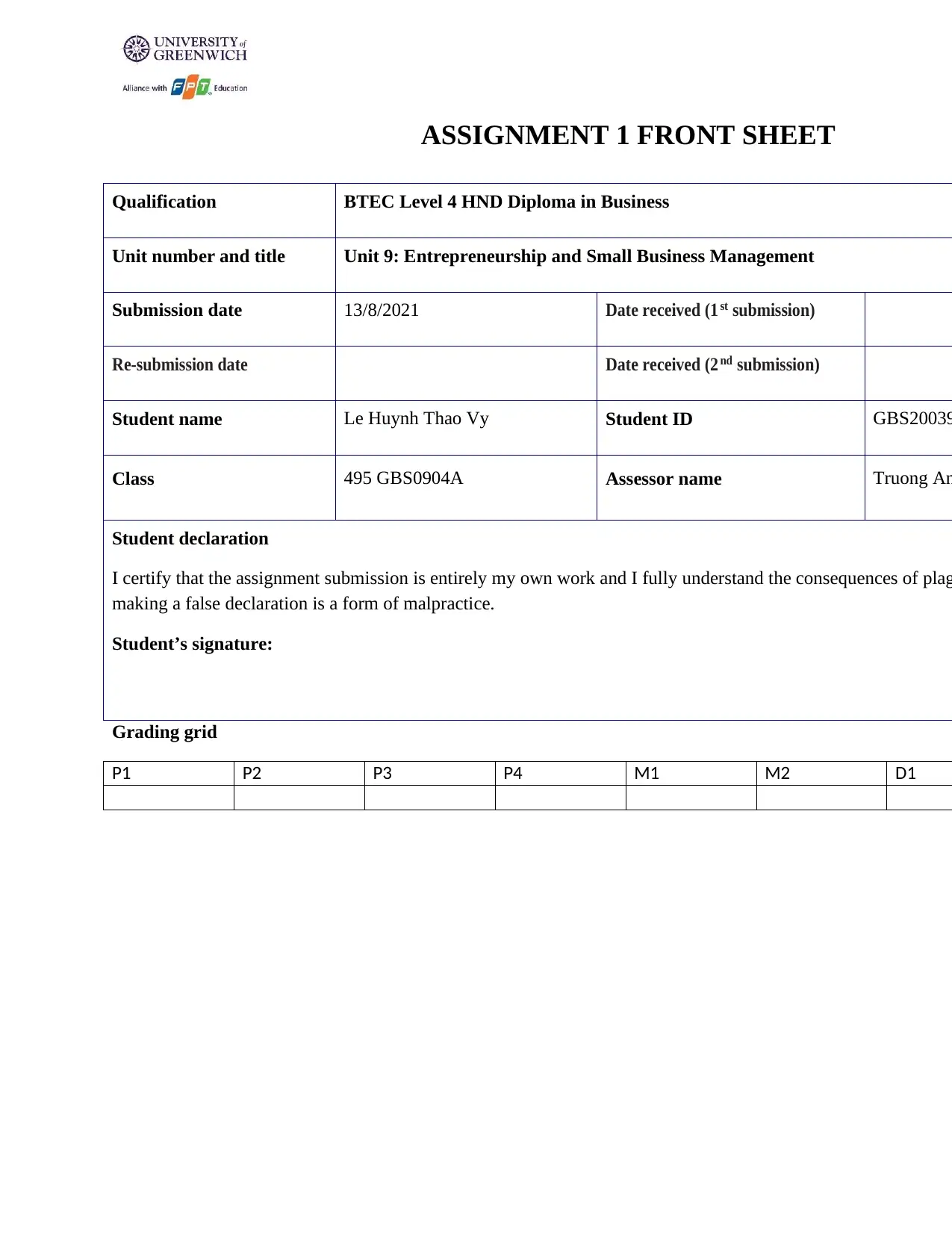
ASSIGNMENT 1 FRONT SHEET
Qualification BTEC Level 4 HND Diploma in Business
Unit number and title Unit 9: Entrepreneurship and Small Business Management
Submission date 13/8/2021 Date received (1 st submission)
Re-submission date Date received (2 nd submission)
Student name Le Huynh Thao Vy Student ID GBS20039
Class 495 GBS0904A Assessor name Truong An
Student declaration
I certify that the assignment submission is entirely my own work and I fully understand the consequences of plag
making a false declaration is a form of malpractice.
Student’s signature:
Grading grid
P1 P2 P3 P4 M1 M2 D1
Qualification BTEC Level 4 HND Diploma in Business
Unit number and title Unit 9: Entrepreneurship and Small Business Management
Submission date 13/8/2021 Date received (1 st submission)
Re-submission date Date received (2 nd submission)
Student name Le Huynh Thao Vy Student ID GBS20039
Class 495 GBS0904A Assessor name Truong An
Student declaration
I certify that the assignment submission is entirely my own work and I fully understand the consequences of plag
making a false declaration is a form of malpractice.
Student’s signature:
Grading grid
P1 P2 P3 P4 M1 M2 D1
Paraphrase This Document
Need a fresh take? Get an instant paraphrase of this document with our AI Paraphraser

Summative Feedbacks: Resubmission Feedbacks:
Grade: Assessor Signature: Date:
Internal Verifier’s Comments:
Signature & Date:
Grade: Assessor Signature: Date:
Internal Verifier’s Comments:
Signature & Date:
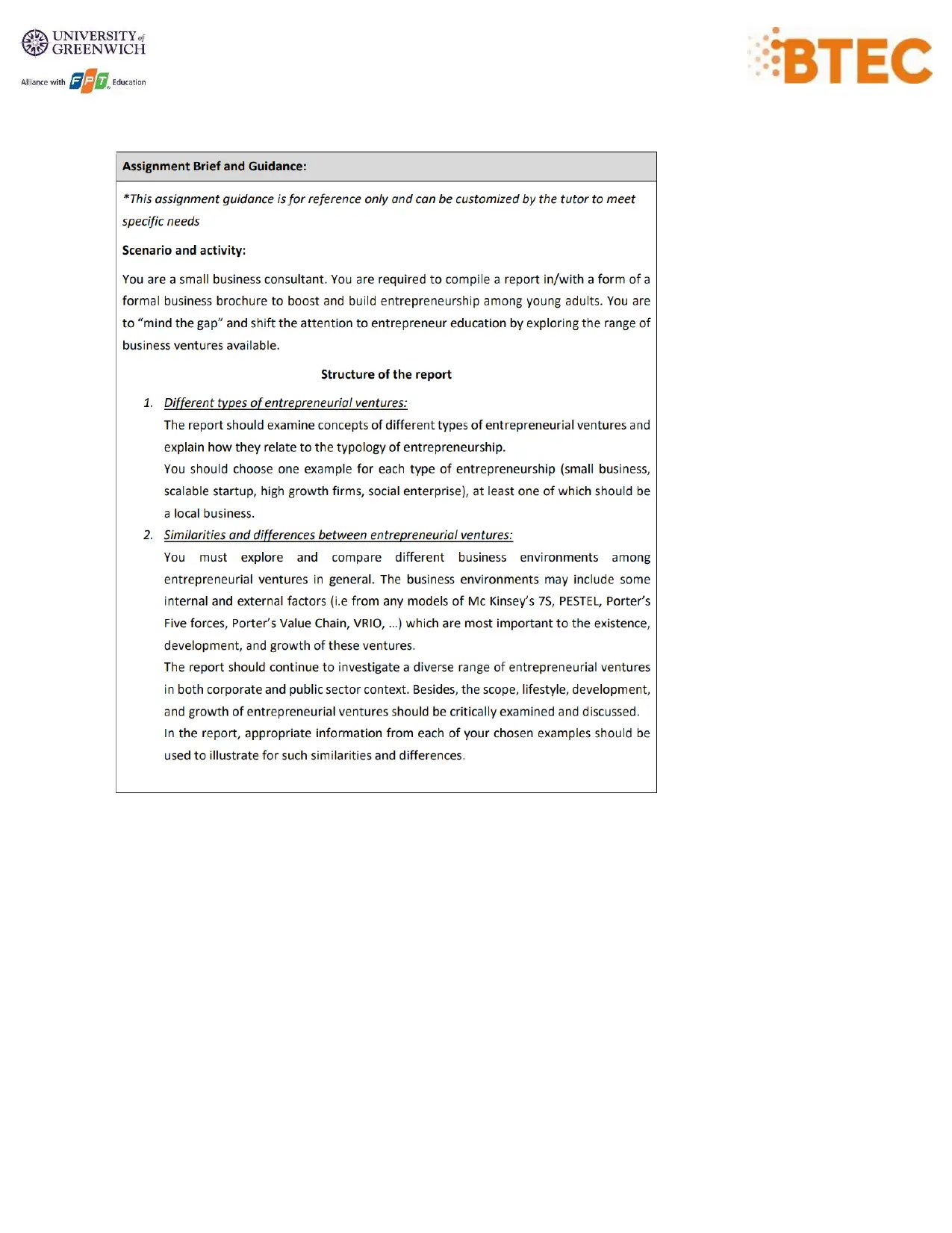
⊘ This is a preview!⊘
Do you want full access?
Subscribe today to unlock all pages.

Trusted by 1+ million students worldwide
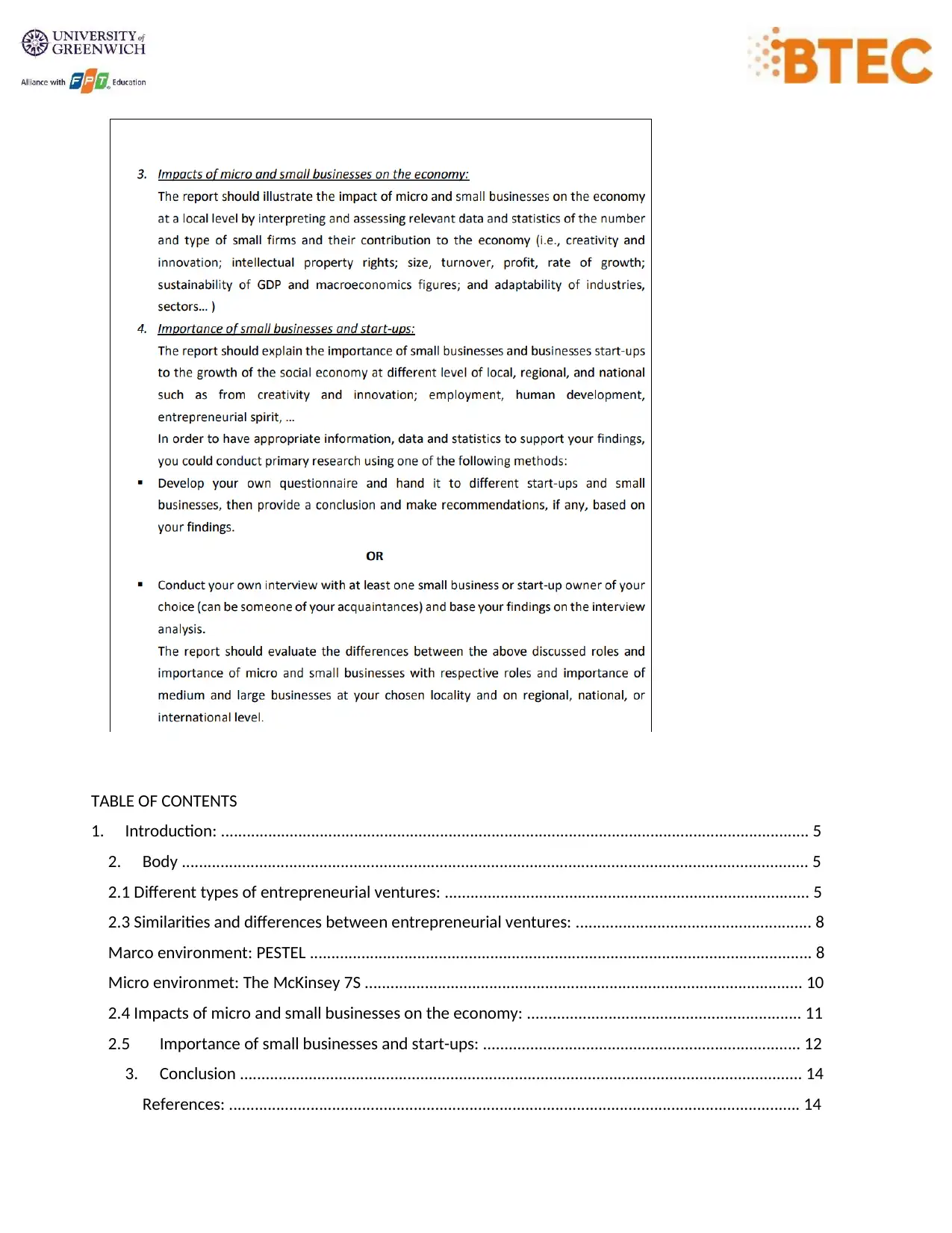
TABLE OF CONTENTS
1. Introduction: ......................................................................................................................................... 5
2. Body .................................................................................................................................................. 5
2.1 Different types of entrepreneurial ventures: ..................................................................................... 5
2.3 Similarities and differences between entrepreneurial ventures: ....................................................... 8
Marco environment: PESTEL ..................................................................................................................... 8
Micro environmet: The McKinsey 7S ...................................................................................................... 10
2.4 Impacts of micro and small businesses on the economy: ................................................................ 11
2.5 Importance of small businesses and start-ups: .......................................................................... 12
3. Conclusion ................................................................................................................................... 14
References: ..................................................................................................................................... 14
1. Introduction: ......................................................................................................................................... 5
2. Body .................................................................................................................................................. 5
2.1 Different types of entrepreneurial ventures: ..................................................................................... 5
2.3 Similarities and differences between entrepreneurial ventures: ....................................................... 8
Marco environment: PESTEL ..................................................................................................................... 8
Micro environmet: The McKinsey 7S ...................................................................................................... 10
2.4 Impacts of micro and small businesses on the economy: ................................................................ 11
2.5 Importance of small businesses and start-ups: .......................................................................... 12
3. Conclusion ................................................................................................................................... 14
References: ..................................................................................................................................... 14
Paraphrase This Document
Need a fresh take? Get an instant paraphrase of this document with our AI Paraphraser
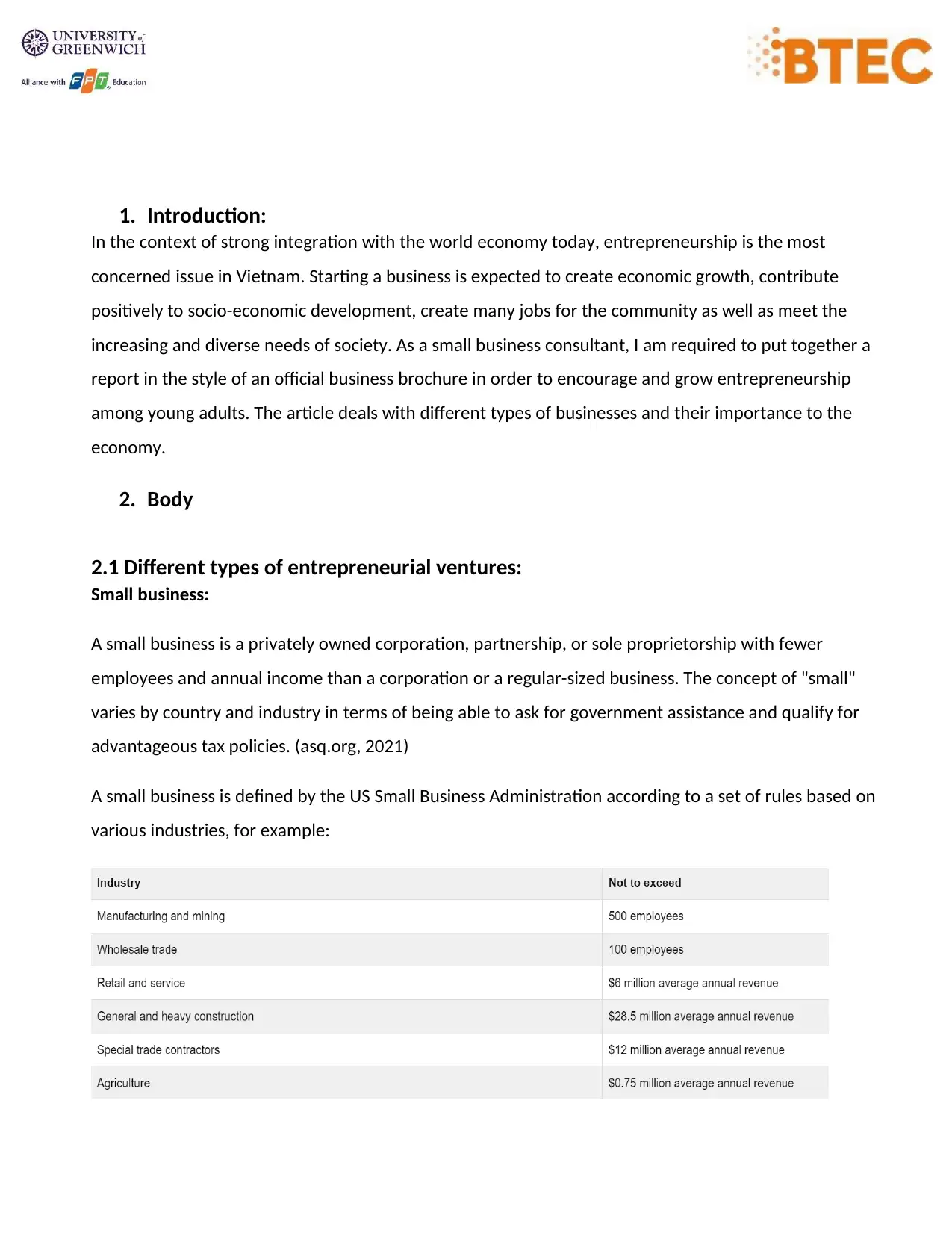
1. Introduction:
In the context of strong integration with the world economy today, entrepreneurship is the most
concerned issue in Vietnam. Starting a business is expected to create economic growth, contribute
positively to socio-economic development, create many jobs for the community as well as meet the
increasing and diverse needs of society. As a small business consultant, I am required to put together a
report in the style of an official business brochure in order to encourage and grow entrepreneurship
among young adults. The article deals with different types of businesses and their importance to the
economy.
2. Body
2.1 Different types of entrepreneurial ventures:
Small business:
A small business is a privately owned corporation, partnership, or sole proprietorship with fewer
employees and annual income than a corporation or a regular-sized business. The concept of "small"
varies by country and industry in terms of being able to ask for government assistance and qualify for
advantageous tax policies. (asq.org, 2021)
A small business is defined by the US Small Business Administration according to a set of rules based on
various industries, for example:
In the context of strong integration with the world economy today, entrepreneurship is the most
concerned issue in Vietnam. Starting a business is expected to create economic growth, contribute
positively to socio-economic development, create many jobs for the community as well as meet the
increasing and diverse needs of society. As a small business consultant, I am required to put together a
report in the style of an official business brochure in order to encourage and grow entrepreneurship
among young adults. The article deals with different types of businesses and their importance to the
economy.
2. Body
2.1 Different types of entrepreneurial ventures:
Small business:
A small business is a privately owned corporation, partnership, or sole proprietorship with fewer
employees and annual income than a corporation or a regular-sized business. The concept of "small"
varies by country and industry in terms of being able to ask for government assistance and qualify for
advantageous tax policies. (asq.org, 2021)
A small business is defined by the US Small Business Administration according to a set of rules based on
various industries, for example:
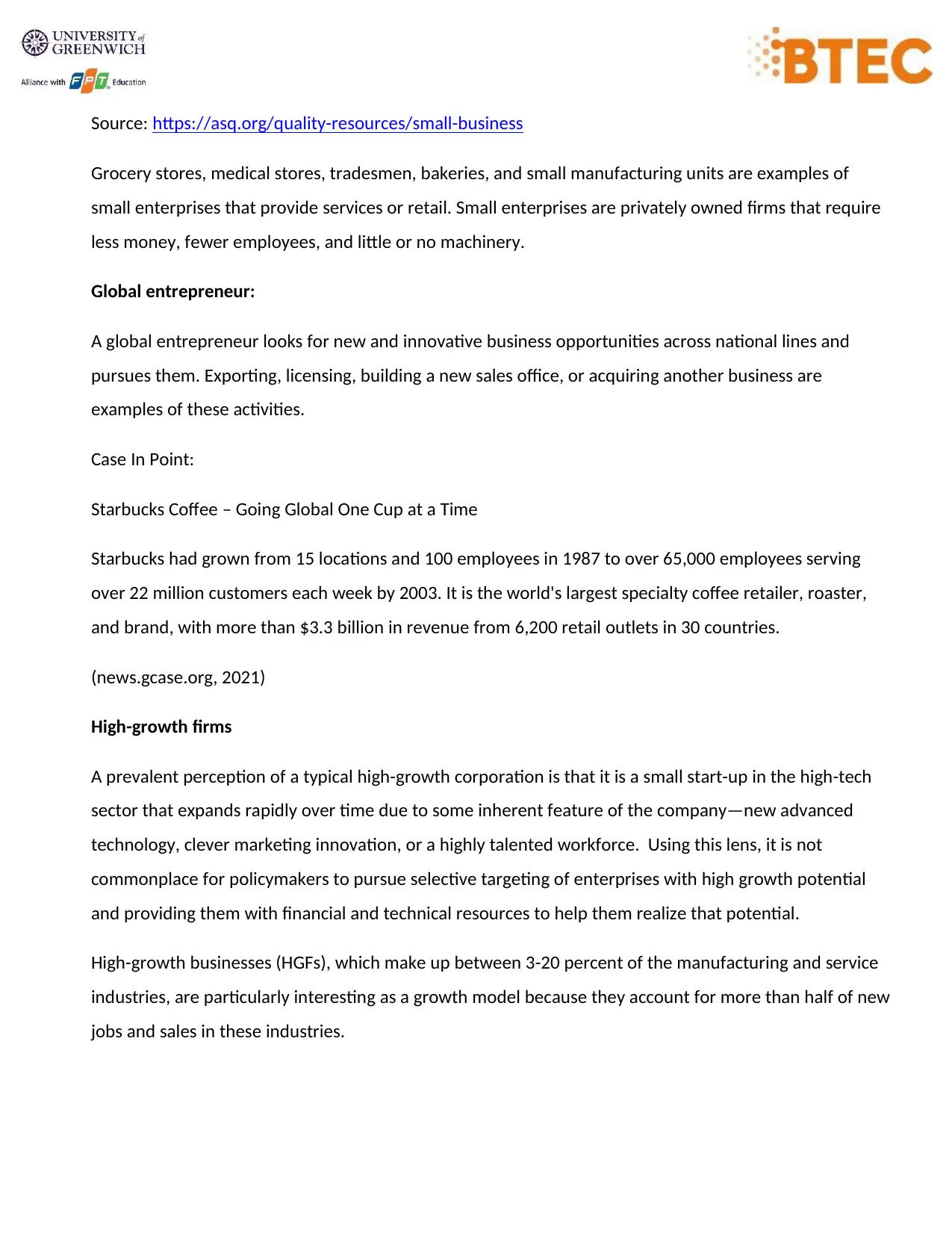
Source: https://asq.org/quality-resources/small-business
Grocery stores, medical stores, tradesmen, bakeries, and small manufacturing units are examples of
small enterprises that provide services or retail. Small enterprises are privately owned firms that require
less money, fewer employees, and little or no machinery.
Global entrepreneur:
A global entrepreneur looks for new and innovative business opportunities across national lines and
pursues them. Exporting, licensing, building a new sales office, or acquiring another business are
examples of these activities.
Case In Point:
Starbucks Coffee – Going Global One Cup at a Time
Starbucks had grown from 15 locations and 100 employees in 1987 to over 65,000 employees serving
over 22 million customers each week by 2003. It is the world's largest specialty coffee retailer, roaster,
and brand, with more than $3.3 billion in revenue from 6,200 retail outlets in 30 countries.
(news.gcase.org, 2021)
High-growth firms
A prevalent perception of a typical high-growth corporation is that it is a small start-up in the high-tech
sector that expands rapidly over time due to some inherent feature of the company—new advanced
technology, clever marketing innovation, or a highly talented workforce. Using this lens, it is not
commonplace for policymakers to pursue selective targeting of enterprises with high growth potential
and providing them with financial and technical resources to help them realize that potential.
High-growth businesses (HGFs), which make up between 3-20 percent of the manufacturing and service
industries, are particularly interesting as a growth model because they account for more than half of new
jobs and sales in these industries.
Grocery stores, medical stores, tradesmen, bakeries, and small manufacturing units are examples of
small enterprises that provide services or retail. Small enterprises are privately owned firms that require
less money, fewer employees, and little or no machinery.
Global entrepreneur:
A global entrepreneur looks for new and innovative business opportunities across national lines and
pursues them. Exporting, licensing, building a new sales office, or acquiring another business are
examples of these activities.
Case In Point:
Starbucks Coffee – Going Global One Cup at a Time
Starbucks had grown from 15 locations and 100 employees in 1987 to over 65,000 employees serving
over 22 million customers each week by 2003. It is the world's largest specialty coffee retailer, roaster,
and brand, with more than $3.3 billion in revenue from 6,200 retail outlets in 30 countries.
(news.gcase.org, 2021)
High-growth firms
A prevalent perception of a typical high-growth corporation is that it is a small start-up in the high-tech
sector that expands rapidly over time due to some inherent feature of the company—new advanced
technology, clever marketing innovation, or a highly talented workforce. Using this lens, it is not
commonplace for policymakers to pursue selective targeting of enterprises with high growth potential
and providing them with financial and technical resources to help them realize that potential.
High-growth businesses (HGFs), which make up between 3-20 percent of the manufacturing and service
industries, are particularly interesting as a growth model because they account for more than half of new
jobs and sales in these industries.
⊘ This is a preview!⊘
Do you want full access?
Subscribe today to unlock all pages.

Trusted by 1+ million students worldwide
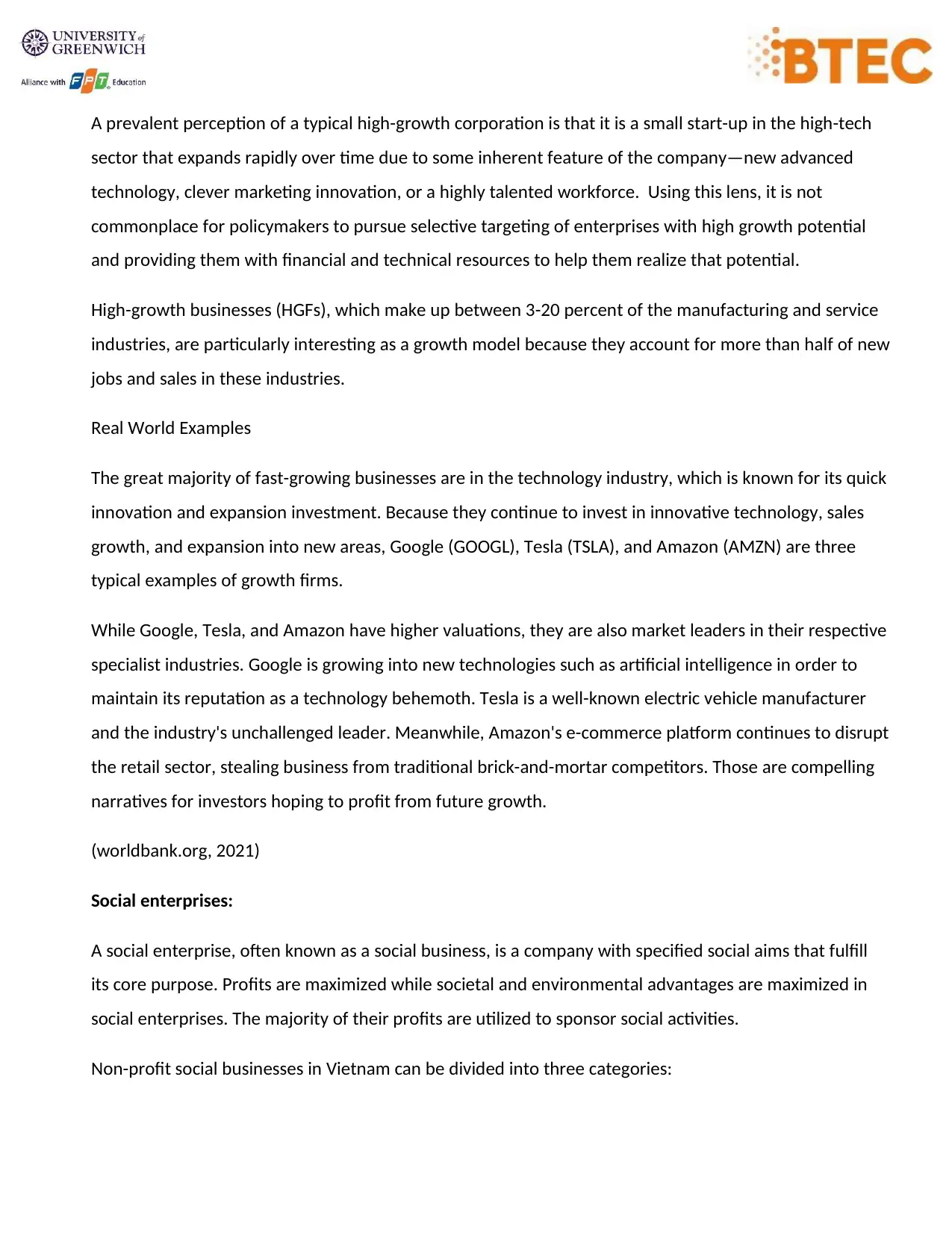
A prevalent perception of a typical high-growth corporation is that it is a small start-up in the high-tech
sector that expands rapidly over time due to some inherent feature of the company—new advanced
technology, clever marketing innovation, or a highly talented workforce. Using this lens, it is not
commonplace for policymakers to pursue selective targeting of enterprises with high growth potential
and providing them with financial and technical resources to help them realize that potential.
High-growth businesses (HGFs), which make up between 3-20 percent of the manufacturing and service
industries, are particularly interesting as a growth model because they account for more than half of new
jobs and sales in these industries.
Real World Examples
The great majority of fast-growing businesses are in the technology industry, which is known for its quick
innovation and expansion investment. Because they continue to invest in innovative technology, sales
growth, and expansion into new areas, Google (GOOGL), Tesla (TSLA), and Amazon (AMZN) are three
typical examples of growth firms.
While Google, Tesla, and Amazon have higher valuations, they are also market leaders in their respective
specialist industries. Google is growing into new technologies such as artificial intelligence in order to
maintain its reputation as a technology behemoth. Tesla is a well-known electric vehicle manufacturer
and the industry's unchallenged leader. Meanwhile, Amazon's e-commerce platform continues to disrupt
the retail sector, stealing business from traditional brick-and-mortar competitors. Those are compelling
narratives for investors hoping to profit from future growth.
(worldbank.org, 2021)
Social enterprises:
A social enterprise, often known as a social business, is a company with specified social aims that fulfill
its core purpose. Profits are maximized while societal and environmental advantages are maximized in
social enterprises. The majority of their profits are utilized to sponsor social activities.
Non-profit social businesses in Vietnam can be divided into three categories:
sector that expands rapidly over time due to some inherent feature of the company—new advanced
technology, clever marketing innovation, or a highly talented workforce. Using this lens, it is not
commonplace for policymakers to pursue selective targeting of enterprises with high growth potential
and providing them with financial and technical resources to help them realize that potential.
High-growth businesses (HGFs), which make up between 3-20 percent of the manufacturing and service
industries, are particularly interesting as a growth model because they account for more than half of new
jobs and sales in these industries.
Real World Examples
The great majority of fast-growing businesses are in the technology industry, which is known for its quick
innovation and expansion investment. Because they continue to invest in innovative technology, sales
growth, and expansion into new areas, Google (GOOGL), Tesla (TSLA), and Amazon (AMZN) are three
typical examples of growth firms.
While Google, Tesla, and Amazon have higher valuations, they are also market leaders in their respective
specialist industries. Google is growing into new technologies such as artificial intelligence in order to
maintain its reputation as a technology behemoth. Tesla is a well-known electric vehicle manufacturer
and the industry's unchallenged leader. Meanwhile, Amazon's e-commerce platform continues to disrupt
the retail sector, stealing business from traditional brick-and-mortar competitors. Those are compelling
narratives for investors hoping to profit from future growth.
(worldbank.org, 2021)
Social enterprises:
A social enterprise, often known as a social business, is a company with specified social aims that fulfill
its core purpose. Profits are maximized while societal and environmental advantages are maximized in
social enterprises. The majority of their profits are utilized to sponsor social activities.
Non-profit social businesses in Vietnam can be divided into three categories:
Paraphrase This Document
Need a fresh take? Get an instant paraphrase of this document with our AI Paraphraser
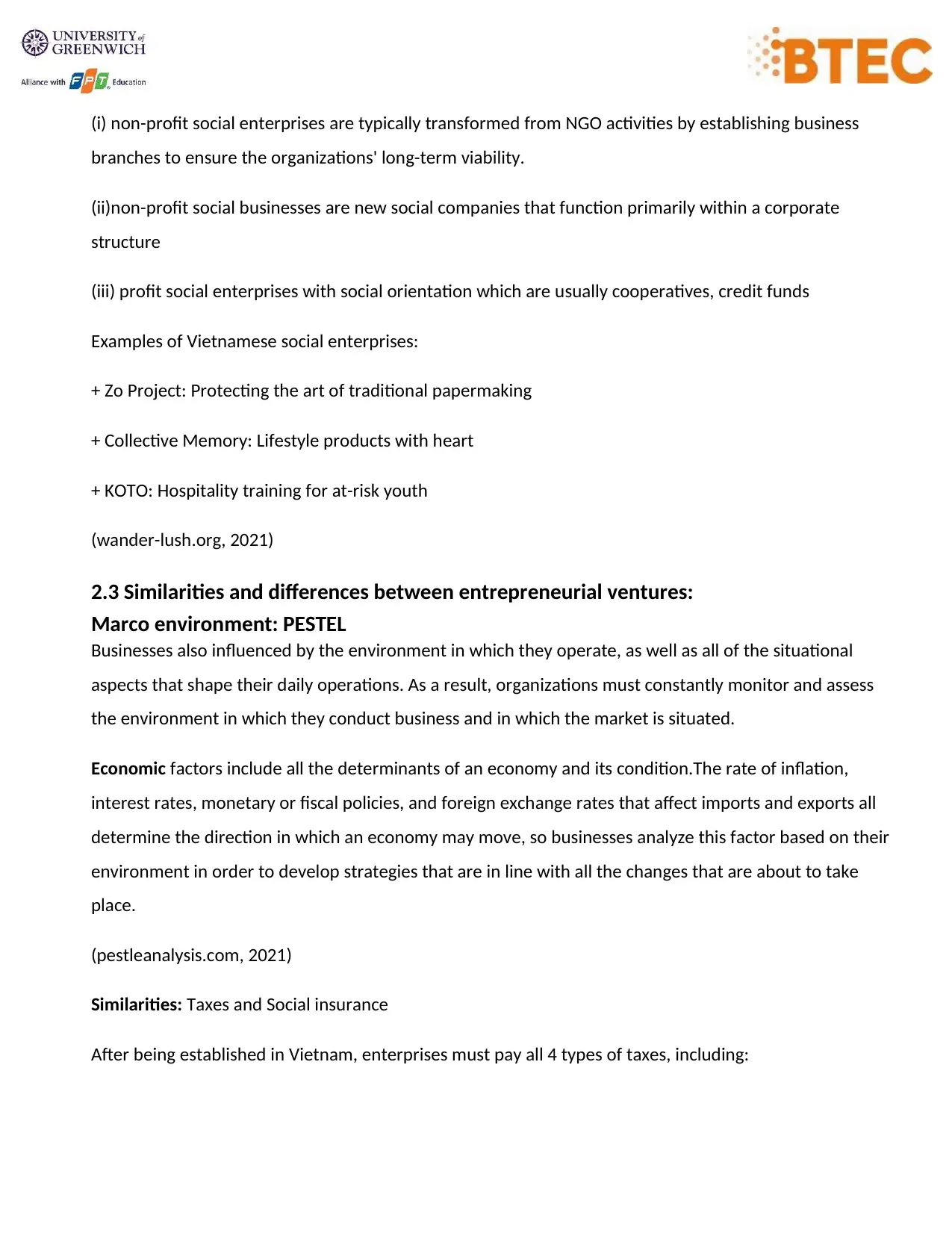
(i) non-profit social enterprises are typically transformed from NGO activities by establishing business
branches to ensure the organizations' long-term viability.
(ii)non-profit social businesses are new social companies that function primarily within a corporate
structure
(iii) profit social enterprises with social orientation which are usually cooperatives, credit funds
Examples of Vietnamese social enterprises:
+ Zo Project: Protecting the art of traditional papermaking
+ Collective Memory: Lifestyle products with heart
+ KOTO: Hospitality training for at-risk youth
(wander-lush.org, 2021)
2.3 Similarities and differences between entrepreneurial ventures:
Marco environment: PESTEL
Businesses also influenced by the environment in which they operate, as well as all of the situational
aspects that shape their daily operations. As a result, organizations must constantly monitor and assess
the environment in which they conduct business and in which the market is situated.
Economic factors include all the determinants of an economy and its condition.The rate of inflation,
interest rates, monetary or fiscal policies, and foreign exchange rates that affect imports and exports all
determine the direction in which an economy may move, so businesses analyze this factor based on their
environment in order to develop strategies that are in line with all the changes that are about to take
place.
(pestleanalysis.com, 2021)
Similarities: Taxes and Social insurance
After being established in Vietnam, enterprises must pay all 4 types of taxes, including:
branches to ensure the organizations' long-term viability.
(ii)non-profit social businesses are new social companies that function primarily within a corporate
structure
(iii) profit social enterprises with social orientation which are usually cooperatives, credit funds
Examples of Vietnamese social enterprises:
+ Zo Project: Protecting the art of traditional papermaking
+ Collective Memory: Lifestyle products with heart
+ KOTO: Hospitality training for at-risk youth
(wander-lush.org, 2021)
2.3 Similarities and differences between entrepreneurial ventures:
Marco environment: PESTEL
Businesses also influenced by the environment in which they operate, as well as all of the situational
aspects that shape their daily operations. As a result, organizations must constantly monitor and assess
the environment in which they conduct business and in which the market is situated.
Economic factors include all the determinants of an economy and its condition.The rate of inflation,
interest rates, monetary or fiscal policies, and foreign exchange rates that affect imports and exports all
determine the direction in which an economy may move, so businesses analyze this factor based on their
environment in order to develop strategies that are in line with all the changes that are about to take
place.
(pestleanalysis.com, 2021)
Similarities: Taxes and Social insurance
After being established in Vietnam, enterprises must pay all 4 types of taxes, including:
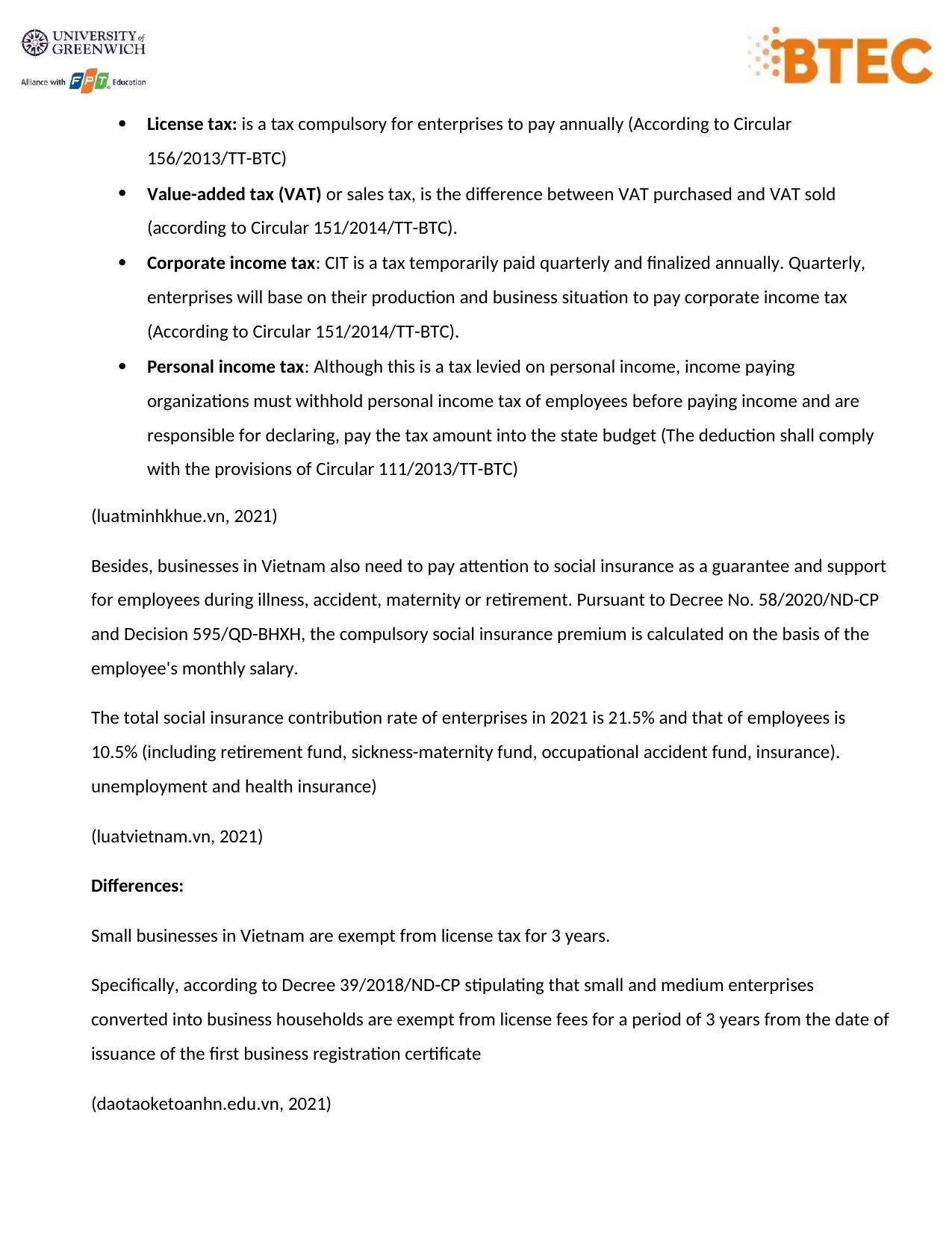
License tax: is a tax compulsory for enterprises to pay annually (According to Circular
156/2013/TT-BTC)
Value-added tax (VAT) or sales tax, is the difference between VAT purchased and VAT sold
(according to Circular 151/2014/TT-BTC).
Corporate income tax: CIT is a tax temporarily paid quarterly and finalized annually. Quarterly,
enterprises will base on their production and business situation to pay corporate income tax
(According to Circular 151/2014/TT-BTC).
Personal income tax: Although this is a tax levied on personal income, income paying
organizations must withhold personal income tax of employees before paying income and are
responsible for declaring, pay the tax amount into the state budget (The deduction shall comply
with the provisions of Circular 111/2013/TT-BTC)
(luatminhkhue.vn, 2021)
Besides, businesses in Vietnam also need to pay attention to social insurance as a guarantee and support
for employees during illness, accident, maternity or retirement. Pursuant to Decree No. 58/2020/ND-CP
and Decision 595/QD-BHXH, the compulsory social insurance premium is calculated on the basis of the
employee's monthly salary.
The total social insurance contribution rate of enterprises in 2021 is 21.5% and that of employees is
10.5% (including retirement fund, sickness-maternity fund, occupational accident fund, insurance).
unemployment and health insurance)
(luatvietnam.vn, 2021)
Differences:
Small businesses in Vietnam are exempt from license tax for 3 years.
Specifically, according to Decree 39/2018/ND-CP stipulating that small and medium enterprises
converted into business households are exempt from license fees for a period of 3 years from the date of
issuance of the first business registration certificate
(daotaoketoanhn.edu.vn, 2021)
156/2013/TT-BTC)
Value-added tax (VAT) or sales tax, is the difference between VAT purchased and VAT sold
(according to Circular 151/2014/TT-BTC).
Corporate income tax: CIT is a tax temporarily paid quarterly and finalized annually. Quarterly,
enterprises will base on their production and business situation to pay corporate income tax
(According to Circular 151/2014/TT-BTC).
Personal income tax: Although this is a tax levied on personal income, income paying
organizations must withhold personal income tax of employees before paying income and are
responsible for declaring, pay the tax amount into the state budget (The deduction shall comply
with the provisions of Circular 111/2013/TT-BTC)
(luatminhkhue.vn, 2021)
Besides, businesses in Vietnam also need to pay attention to social insurance as a guarantee and support
for employees during illness, accident, maternity or retirement. Pursuant to Decree No. 58/2020/ND-CP
and Decision 595/QD-BHXH, the compulsory social insurance premium is calculated on the basis of the
employee's monthly salary.
The total social insurance contribution rate of enterprises in 2021 is 21.5% and that of employees is
10.5% (including retirement fund, sickness-maternity fund, occupational accident fund, insurance).
unemployment and health insurance)
(luatvietnam.vn, 2021)
Differences:
Small businesses in Vietnam are exempt from license tax for 3 years.
Specifically, according to Decree 39/2018/ND-CP stipulating that small and medium enterprises
converted into business households are exempt from license fees for a period of 3 years from the date of
issuance of the first business registration certificate
(daotaoketoanhn.edu.vn, 2021)
⊘ This is a preview!⊘
Do you want full access?
Subscribe today to unlock all pages.

Trusted by 1+ million students worldwide
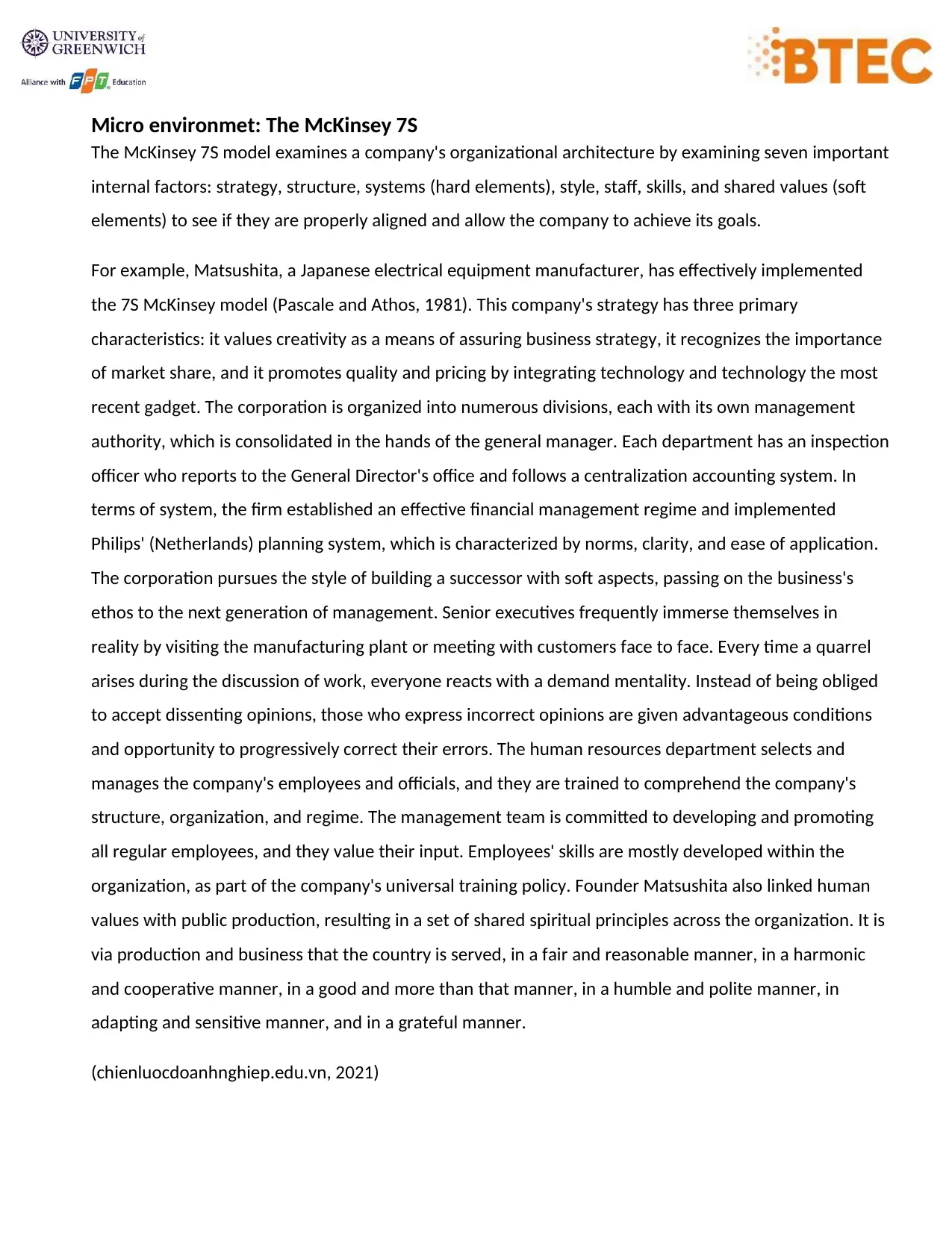
Micro environmet: The McKinsey 7S
The McKinsey 7S model examines a company's organizational architecture by examining seven important
internal factors: strategy, structure, systems (hard elements), style, staff, skills, and shared values (soft
elements) to see if they are properly aligned and allow the company to achieve its goals.
For example, Matsushita, a Japanese electrical equipment manufacturer, has effectively implemented
the 7S McKinsey model (Pascale and Athos, 1981). This company's strategy has three primary
characteristics: it values creativity as a means of assuring business strategy, it recognizes the importance
of market share, and it promotes quality and pricing by integrating technology and technology the most
recent gadget. The corporation is organized into numerous divisions, each with its own management
authority, which is consolidated in the hands of the general manager. Each department has an inspection
officer who reports to the General Director's office and follows a centralization accounting system. In
terms of system, the firm established an effective financial management regime and implemented
Philips' (Netherlands) planning system, which is characterized by norms, clarity, and ease of application.
The corporation pursues the style of building a successor with soft aspects, passing on the business's
ethos to the next generation of management. Senior executives frequently immerse themselves in
reality by visiting the manufacturing plant or meeting with customers face to face. Every time a quarrel
arises during the discussion of work, everyone reacts with a demand mentality. Instead of being obliged
to accept dissenting opinions, those who express incorrect opinions are given advantageous conditions
and opportunity to progressively correct their errors. The human resources department selects and
manages the company's employees and officials, and they are trained to comprehend the company's
structure, organization, and regime. The management team is committed to developing and promoting
all regular employees, and they value their input. Employees' skills are mostly developed within the
organization, as part of the company's universal training policy. Founder Matsushita also linked human
values with public production, resulting in a set of shared spiritual principles across the organization. It is
via production and business that the country is served, in a fair and reasonable manner, in a harmonic
and cooperative manner, in a good and more than that manner, in a humble and polite manner, in
adapting and sensitive manner, and in a grateful manner.
(chienluocdoanhnghiep.edu.vn, 2021)
The McKinsey 7S model examines a company's organizational architecture by examining seven important
internal factors: strategy, structure, systems (hard elements), style, staff, skills, and shared values (soft
elements) to see if they are properly aligned and allow the company to achieve its goals.
For example, Matsushita, a Japanese electrical equipment manufacturer, has effectively implemented
the 7S McKinsey model (Pascale and Athos, 1981). This company's strategy has three primary
characteristics: it values creativity as a means of assuring business strategy, it recognizes the importance
of market share, and it promotes quality and pricing by integrating technology and technology the most
recent gadget. The corporation is organized into numerous divisions, each with its own management
authority, which is consolidated in the hands of the general manager. Each department has an inspection
officer who reports to the General Director's office and follows a centralization accounting system. In
terms of system, the firm established an effective financial management regime and implemented
Philips' (Netherlands) planning system, which is characterized by norms, clarity, and ease of application.
The corporation pursues the style of building a successor with soft aspects, passing on the business's
ethos to the next generation of management. Senior executives frequently immerse themselves in
reality by visiting the manufacturing plant or meeting with customers face to face. Every time a quarrel
arises during the discussion of work, everyone reacts with a demand mentality. Instead of being obliged
to accept dissenting opinions, those who express incorrect opinions are given advantageous conditions
and opportunity to progressively correct their errors. The human resources department selects and
manages the company's employees and officials, and they are trained to comprehend the company's
structure, organization, and regime. The management team is committed to developing and promoting
all regular employees, and they value their input. Employees' skills are mostly developed within the
organization, as part of the company's universal training policy. Founder Matsushita also linked human
values with public production, resulting in a set of shared spiritual principles across the organization. It is
via production and business that the country is served, in a fair and reasonable manner, in a harmonic
and cooperative manner, in a good and more than that manner, in a humble and polite manner, in
adapting and sensitive manner, and in a grateful manner.
(chienluocdoanhnghiep.edu.vn, 2021)
Paraphrase This Document
Need a fresh take? Get an instant paraphrase of this document with our AI Paraphraser
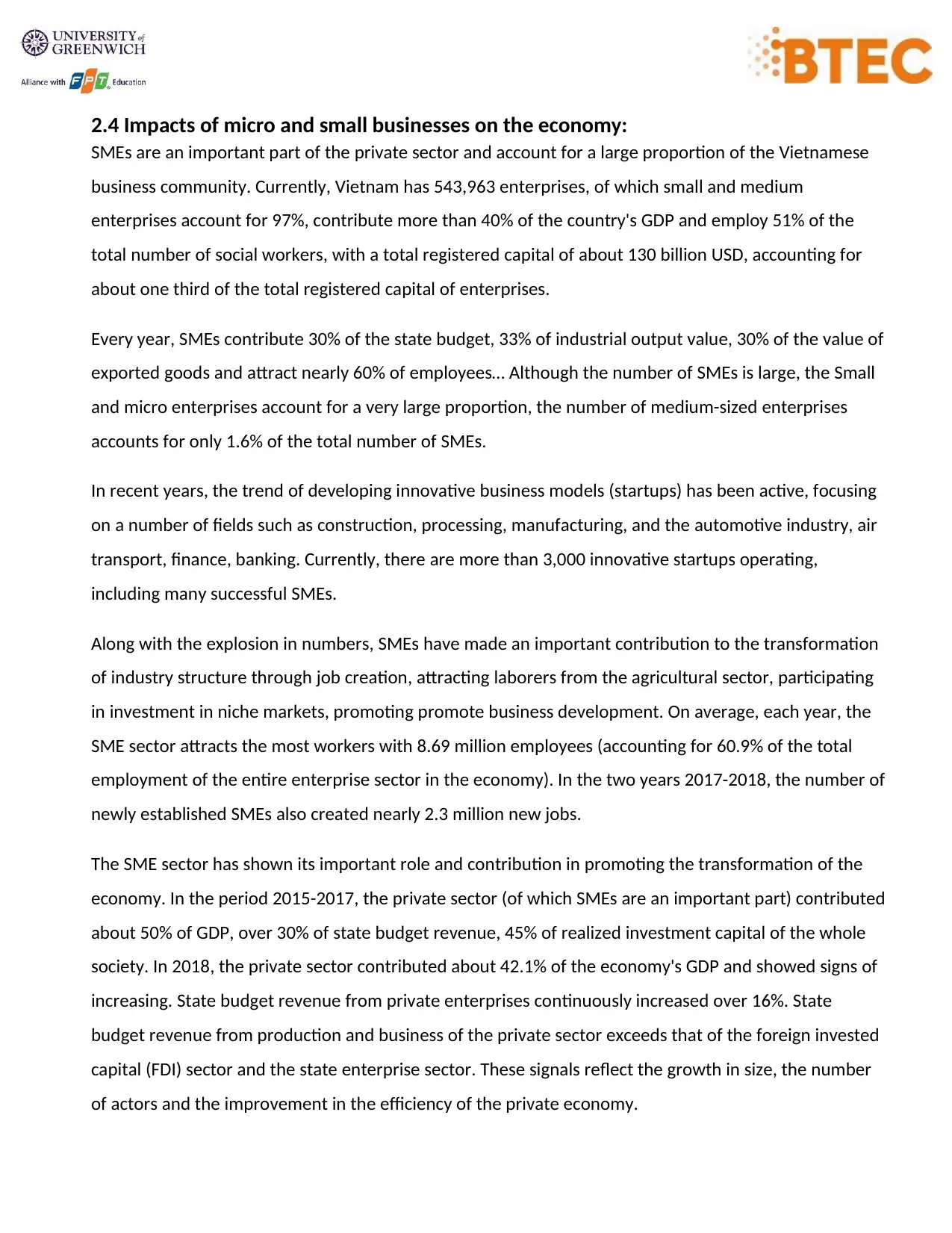
2.4 Impacts of micro and small businesses on the economy:
SMEs are an important part of the private sector and account for a large proportion of the Vietnamese
business community. Currently, Vietnam has 543,963 enterprises, of which small and medium
enterprises account for 97%, contribute more than 40% of the country's GDP and employ 51% of the
total number of social workers, with a total registered capital of about 130 billion USD, accounting for
about one third of the total registered capital of enterprises.
Every year, SMEs contribute 30% of the state budget, 33% of industrial output value, 30% of the value of
exported goods and attract nearly 60% of employees… Although the number of SMEs is large, the Small
and micro enterprises account for a very large proportion, the number of medium-sized enterprises
accounts for only 1.6% of the total number of SMEs.
In recent years, the trend of developing innovative business models (startups) has been active, focusing
on a number of fields such as construction, processing, manufacturing, and the automotive industry, air
transport, finance, banking. Currently, there are more than 3,000 innovative startups operating,
including many successful SMEs.
Along with the explosion in numbers, SMEs have made an important contribution to the transformation
of industry structure through job creation, attracting laborers from the agricultural sector, participating
in investment in niche markets, promoting promote business development. On average, each year, the
SME sector attracts the most workers with 8.69 million employees (accounting for 60.9% of the total
employment of the entire enterprise sector in the economy). In the two years 2017-2018, the number of
newly established SMEs also created nearly 2.3 million new jobs.
The SME sector has shown its important role and contribution in promoting the transformation of the
economy. In the period 2015-2017, the private sector (of which SMEs are an important part) contributed
about 50% of GDP, over 30% of state budget revenue, 45% of realized investment capital of the whole
society. In 2018, the private sector contributed about 42.1% of the economy's GDP and showed signs of
increasing. State budget revenue from private enterprises continuously increased over 16%. State
budget revenue from production and business of the private sector exceeds that of the foreign invested
capital (FDI) sector and the state enterprise sector. These signals reflect the growth in size, the number
of actors and the improvement in the efficiency of the private economy.
SMEs are an important part of the private sector and account for a large proportion of the Vietnamese
business community. Currently, Vietnam has 543,963 enterprises, of which small and medium
enterprises account for 97%, contribute more than 40% of the country's GDP and employ 51% of the
total number of social workers, with a total registered capital of about 130 billion USD, accounting for
about one third of the total registered capital of enterprises.
Every year, SMEs contribute 30% of the state budget, 33% of industrial output value, 30% of the value of
exported goods and attract nearly 60% of employees… Although the number of SMEs is large, the Small
and micro enterprises account for a very large proportion, the number of medium-sized enterprises
accounts for only 1.6% of the total number of SMEs.
In recent years, the trend of developing innovative business models (startups) has been active, focusing
on a number of fields such as construction, processing, manufacturing, and the automotive industry, air
transport, finance, banking. Currently, there are more than 3,000 innovative startups operating,
including many successful SMEs.
Along with the explosion in numbers, SMEs have made an important contribution to the transformation
of industry structure through job creation, attracting laborers from the agricultural sector, participating
in investment in niche markets, promoting promote business development. On average, each year, the
SME sector attracts the most workers with 8.69 million employees (accounting for 60.9% of the total
employment of the entire enterprise sector in the economy). In the two years 2017-2018, the number of
newly established SMEs also created nearly 2.3 million new jobs.
The SME sector has shown its important role and contribution in promoting the transformation of the
economy. In the period 2015-2017, the private sector (of which SMEs are an important part) contributed
about 50% of GDP, over 30% of state budget revenue, 45% of realized investment capital of the whole
society. In 2018, the private sector contributed about 42.1% of the economy's GDP and showed signs of
increasing. State budget revenue from private enterprises continuously increased over 16%. State
budget revenue from production and business of the private sector exceeds that of the foreign invested
capital (FDI) sector and the state enterprise sector. These signals reflect the growth in size, the number
of actors and the improvement in the efficiency of the private economy.
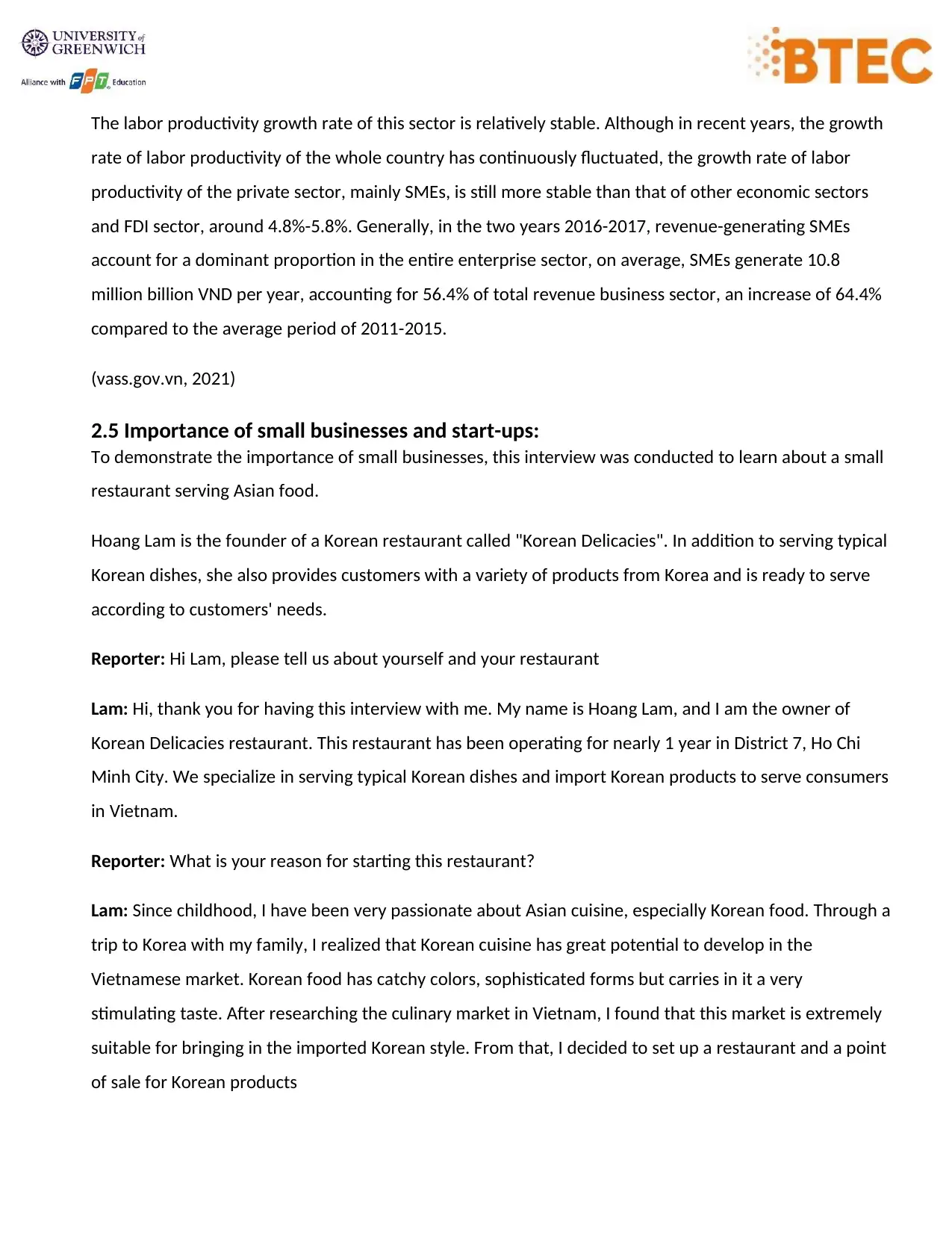
The labor productivity growth rate of this sector is relatively stable. Although in recent years, the growth
rate of labor productivity of the whole country has continuously fluctuated, the growth rate of labor
productivity of the private sector, mainly SMEs, is still more stable than that of other economic sectors
and FDI sector, around 4.8%-5.8%. Generally, in the two years 2016-2017, revenue-generating SMEs
account for a dominant proportion in the entire enterprise sector, on average, SMEs generate 10.8
million billion VND per year, accounting for 56.4% of total revenue business sector, an increase of 64.4%
compared to the average period of 2011-2015.
(vass.gov.vn, 2021)
2.5 Importance of small businesses and start-ups:
To demonstrate the importance of small businesses, this interview was conducted to learn about a small
restaurant serving Asian food.
Hoang Lam is the founder of a Korean restaurant called "Korean Delicacies". In addition to serving typical
Korean dishes, she also provides customers with a variety of products from Korea and is ready to serve
according to customers' needs.
Reporter: Hi Lam, please tell us about yourself and your restaurant
Lam: Hi, thank you for having this interview with me. My name is Hoang Lam, and I am the owner of
Korean Delicacies restaurant. This restaurant has been operating for nearly 1 year in District 7, Ho Chi
Minh City. We specialize in serving typical Korean dishes and import Korean products to serve consumers
in Vietnam.
Reporter: What is your reason for starting this restaurant?
Lam: Since childhood, I have been very passionate about Asian cuisine, especially Korean food. Through a
trip to Korea with my family, I realized that Korean cuisine has great potential to develop in the
Vietnamese market. Korean food has catchy colors, sophisticated forms but carries in it a very
stimulating taste. After researching the culinary market in Vietnam, I found that this market is extremely
suitable for bringing in the imported Korean style. From that, I decided to set up a restaurant and a point
of sale for Korean products
rate of labor productivity of the whole country has continuously fluctuated, the growth rate of labor
productivity of the private sector, mainly SMEs, is still more stable than that of other economic sectors
and FDI sector, around 4.8%-5.8%. Generally, in the two years 2016-2017, revenue-generating SMEs
account for a dominant proportion in the entire enterprise sector, on average, SMEs generate 10.8
million billion VND per year, accounting for 56.4% of total revenue business sector, an increase of 64.4%
compared to the average period of 2011-2015.
(vass.gov.vn, 2021)
2.5 Importance of small businesses and start-ups:
To demonstrate the importance of small businesses, this interview was conducted to learn about a small
restaurant serving Asian food.
Hoang Lam is the founder of a Korean restaurant called "Korean Delicacies". In addition to serving typical
Korean dishes, she also provides customers with a variety of products from Korea and is ready to serve
according to customers' needs.
Reporter: Hi Lam, please tell us about yourself and your restaurant
Lam: Hi, thank you for having this interview with me. My name is Hoang Lam, and I am the owner of
Korean Delicacies restaurant. This restaurant has been operating for nearly 1 year in District 7, Ho Chi
Minh City. We specialize in serving typical Korean dishes and import Korean products to serve consumers
in Vietnam.
Reporter: What is your reason for starting this restaurant?
Lam: Since childhood, I have been very passionate about Asian cuisine, especially Korean food. Through a
trip to Korea with my family, I realized that Korean cuisine has great potential to develop in the
Vietnamese market. Korean food has catchy colors, sophisticated forms but carries in it a very
stimulating taste. After researching the culinary market in Vietnam, I found that this market is extremely
suitable for bringing in the imported Korean style. From that, I decided to set up a restaurant and a point
of sale for Korean products
⊘ This is a preview!⊘
Do you want full access?
Subscribe today to unlock all pages.

Trusted by 1+ million students worldwide
1 out of 15
Related Documents
Your All-in-One AI-Powered Toolkit for Academic Success.
+13062052269
info@desklib.com
Available 24*7 on WhatsApp / Email
![[object Object]](/_next/static/media/star-bottom.7253800d.svg)
Unlock your academic potential
Copyright © 2020–2025 A2Z Services. All Rights Reserved. Developed and managed by ZUCOL.





